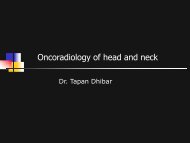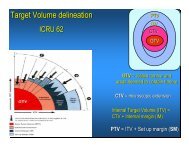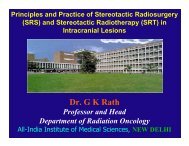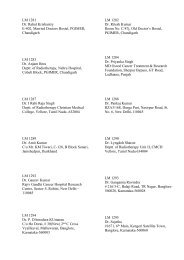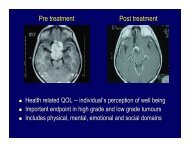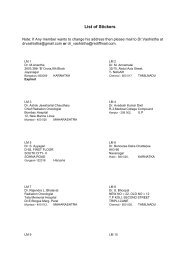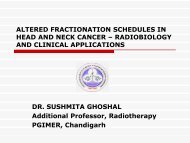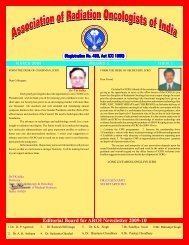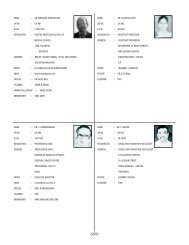Pathology of Head and Neck Malignancies - Aroi.org
Pathology of Head and Neck Malignancies - Aroi.org
Pathology of Head and Neck Malignancies - Aroi.org
Create successful ePaper yourself
Turn your PDF publications into a flip-book with our unique Google optimized e-Paper software.
Tumors <strong>of</strong> the upper respiratory tractA. Nasal cavity, paranasal sinuses <strong>and</strong>Nasopharynx– Primary tumors– Secondary tumorsB. Larynx <strong>and</strong> Trachea
Primary tumors• Epithelial <strong>and</strong> neuroectodermal tumors• S<strong>of</strong>t tissue tumors• Hematolymphoid tumors• Tumors <strong>of</strong> bone <strong>and</strong> cartilage• Miscellaneous tumors
Malignant epithelial <strong>and</strong> neuroectodermaltumors• Squamous cell carcinoma• Adenocarcinoma• Salivary gl<strong>and</strong> tumors• Sinonasal undifferentiated carcinoma• Neuroectodermal tumors
Carcinoma <strong>of</strong> nasal vestibule• Uncommon• Age: 52-82, M>F• Nasal vestibule or atmucocutaneousjunction• WD-SCC/basal cellcarcinoma• Treat: localexcision/radiotherapy• Prognosis: Excellent
Squamous cell carcinoma <strong>of</strong>sinonasal tract <strong>and</strong> nasopharynxSquamous cell carcinoma– Keratinizing– exophytic / papillary / verrucous / spindle cell /basaloid / adenosquamous– Non-keratinizing• respiratory epith, transitional, cylindrical cell
SCC Conventional type• 3% <strong>of</strong> all head & neck cancersF 6 th & 7 th decades (95% pts >40 yrs)• Max antrum, nasal cavity, ethmoid, sphenoid &frontal sinuses• Fascial asymmetry, unilateral nasal obs, epistaxis,mass lesion, pain, persistent purulent rhinorrhoea,non-healing ulcer, exophthalmos• Diagnosis is <strong>of</strong>ten delayed (signs/symptoms aresimilar to those <strong>of</strong> chronic sinusitis)
• Secondary malignancyeither at another mucosalsite or lung, GIT, breast• Exophytic, papillary,fungating, inverted growthWell circumscribed,expansile, necrotic, fragiledestructive1. Keratinizing: WD, MD,PD
2. Non-keratinizing• Treat: complete surgicalresection & adjuvant RTLocal recurrence: frequent• Prognosis: poor• Higher stage, inv > 1anatomic sites, extensionbeyond nasal cavity ¶nasal sinuses, LN• Diffuse /single cell invasion associated with survival <strong>of</strong> 30-40% compared to 80-90% survival in pts with cohesive orpushing pattern
Verrucous carcinoma• WD locally destructive• Oral cavity →larynx→nasal fossa →sinonasaltract →nasopharynx• Tan/white, warty/fungating / exophytic,firm to hardAdequate biopsy (ampleeith & stromal tissue)• Must be differentiatedfrom SCC
Spindle cell squamous carcinoma• Fungating, ulcerating,polypoidal / exophytic• Malignant undifferentiatedspindle cell proliferation inpresence <strong>of</strong> differentiatedsquamous cell component• CK –negative in upto 40%<strong>of</strong> cases• Prognosis: worse
Basaloid Squamous cell carcinoma• Pyriform sinus, supraglottic,oral cavity, tongue, tonsil,palate• Alcohol, tobacco use• Solid, lobular, cribriform, nest,cords, trabeculae• Aggressive, high grade,multifocal, deeply invasive &metastatic even at initialpresentationEarly mets to LN & visceral<strong>org</strong>ans• Treat: Radical excision, neckdissection, RT & CT
Adenosquamous carcinoma• Uncommon• Larynx, oral cavity,sinonasal cavity• Exophytic,submucosal, friable,edematous <strong>org</strong>ranular
Nasopharyngeal Carcinoma• Age range: wide, common 4 th -6 th decades
• Genetic susceptibility:HLA-A2, B17, Bw46, BW58• EBV 75-100%Salted fish, poor hygiene,smoke, tobacco, chemicalfumes, harbal medicineA. Keratinizing: WD, MD,PD25% <strong>of</strong> all NPCrare under 40 yrs <strong>of</strong> ageB. Non-keratinizing– Differentiated– Undifferentiated
• Non-keratinizing– differentiated 12%– Undifferentiated type60%• D/D: NHL• Treat: RT• Prog: clinical stage, sex,age, genetic factor
Sinonasal undifferentiated carcinoma• High grade malig epithneoplasm with/withoutNE differentiation• Highly aggressive• RT, CTCT→RT →radicalsurgery (improvedsurvival)
Olfactory neuroblastoma• Upper1/3 rd – ½ <strong>of</strong> nasal septum, cribriform plate,superior-medial surface <strong>of</strong> superior turbinate• Most common site: upper nasal cavity• Uncommon (M>F)3 yrs- 9 th decade (bimodal peak in 2 nd & 6 thdecades)• Nasal obstruction, epistaxis, anosmia, headache,pain, lacrimation
Gr I: mitosis, & necrosisabsentGr II: mitosis+, pleo+,less NFGr III: M+, N+, pleo+, NFfocally, Calcifn-Gr IV: NF-• Mixed ONB & carcinoma:ONB+ Adca, SCC,undifferentiatedcarcinoma
CGNFSynS100
EM: dense core neurosecretory granules 80-250 nm
Treat: complete surgical eradication followed by RT5-year survivalStage A: confined to nasal cavity - 75%Stage B: (most common) nasal cavity + one ormore paranasal sinuses - 68%Stage C: beyond sinonasal cavity - 41%• Overall 5-, 10-, & 15-year survival rates were 78%,71% & 68% respectively (Arch Otolaryngol 1984;110:123-126)
Neuroendocrine carcinoma• WD, MD, PD (small cell &large cell variant)• Uncommon• Upper aerodigestive tract,larynx, sinonasal tract• CK, NSE, CG, Syn, S100• Treat: CT, RT
Mucosal malignant melanoma• 0.5-3% <strong>of</strong> all melanomas• 6 th – 8 th decades• Caucasions• Etiology: not knownTobacco smoking in laryngeal MM• Airway obstruction, epistaxis, pain, non-healing ulcer& dysphagia• Polypoidal, sessile, brown, black, pink or white,friable
• Epithelioid• Spindle cell• Mixed cell typeIHC: S100, HMB-45
EM: melanosome &premelanosome• Aggressive & highly lethalTmRadical surgical excision• Prog: poor5-year survival
Sinonasal adenocarcinoma• 10-20% <strong>of</strong> all primary malignant neoplasms• Intestinal / non-intestinal types• M>F• 5 th -7 th decades• Intestinal type most frequently involve ethmoidsinus, may arise anywhere• Nasal stuffiness, obstruction, epistaxis• Woodworkers, workers in shoe & furnitureindustries• Non-intestinal: no gender predilection, nooccupational/environmental factors
• Intestinal/colonic types:papillary-tubular, alveolarmucoid,alveolar-goblet cell,signet-ring & mixed– Papillary-tubular:• Grade I: papillary, singlelayered pseudostratifiedcolumnar epith, mild pleo• Grade II: tubular >papillary• Non-intestinal:- low/high grade- Papillary, clear cell &oncocytic• Treat: complete surgicalexcision
Malignant salivary gl<strong>and</strong> tumors1. ACC 5% <strong>of</strong> sinonasalmalignancies2. Mucoepidermoid carcinoma3. Acinic cell carcinoma• Maxillary sinus-most common• Treat: WLE & post op RTRecurrence: high, related toinadequate surgical excision• 5-yr & 20-yr survival rates are75% & 13% respectively10-yr survival <strong>of</strong> 75%, 43% <strong>and</strong>15% with stage I, II, <strong>and</strong> III & IV
Non-epithelial malignant neoplasm• NHL– Angiocentric T/NK cell lymphoma– B-cell lineage malignant lymphoma– Plasmacytoma• Rhabdomyosarcoma• Chondrosarcoma• Osteosarcoma• Ewing’s sarcoma• Teratocarcinosarcoma
NHL • Nasal angiocentric T/NK celllymphoma, angiocentricimmunoproliferative lesions,PTCL• Low gr: nasal obstruction• High gr: non-healing ulcer,cranial nerve inv, facial swelling,pain, epistaxis• DLBCL: s<strong>of</strong>t tissue/osseousdestruction, proptosis• Angiocentric T/NK celllymphoma: mid-facial regiondestruction• 1.5% <strong>of</strong> NHL in USA• 6.7-8% in Asia/south America• 6 th -8 th decades• Nasal cavity/paranasal sinuses
Extramedullary plasmacytoma• 3-5% <strong>of</strong> all plasma cellneoplasms8% <strong>of</strong> EMP in head & neck8% primary• M>F• Usually 40 yrs <strong>of</strong> age• 25% pts have M component• Disappearance <strong>of</strong> Mcomponent may be indicative<strong>of</strong> cure• RT or local resection followedby RT• Median survival 7-9 yrs / afterdissemination
Rhabdomyosarcoma• Primarily a disease <strong>of</strong> pediatric population• 50% <strong>of</strong> all s<strong>of</strong>t tissue sarcomas in head & neck• In pediatric age groups up to 75%• Most common aural malignancyOrbit, nasopharynx, middle ear/temporal bone,sinonasal tract• Nodular, lobular or polypoid mass25% assume sarcoma botryoides• Embryonal 80-85%, alveolar 10-15%Spindle cell & pleomorphic types: rare
• With surgical excision 5-yr survival
Kaposi’s sarcomaAngiosarcoma
Osteosarcoma• 10% <strong>of</strong> OS occur in head & neck• Most common primary malignant tumor <strong>of</strong>jaw (m<strong>and</strong>ible>maxilla)• Etiology– Most arise de novo– Radiation therapy, Paget’s disease, fibrousdysplasia• Elevated serum alkaline phosphatase
Osteosarcoma• Crani<strong>of</strong>acial OS havebetter prognosis thanextrafacial tumor• Overall 5-yr survival
Chondrosarcoma• 5-12%• 4 th -7 th decades• 2% in pts
Malignant teratoma• Unique sinonasalmalignancyCarcinosarcoma &teratoma (primitiveneuroepith)Neuroectodermal Tm withdivergent different n• Adults• Prognosis: 60% pts notsurviving beyond 3 yrs
Tumors <strong>of</strong> oral cavity• Squamous cell carcinoma– Spindle cell ca– Adenoid squamous cell & adenosquamous– Basaloid squamous cell carcinoma– Verrucous squamous cell carcinoma– Papillary squamous cell carcinoma• Odontogenic carcinomas– Malignant ameloblastoma– Primary intraosseous carcinoma– Malignant odontogenic epithelial tumors– Clear cell odontogenic carcinoma• Odontogenic sarcomas– Ameloblastic fibrosarcopma– Ameloblastic fibrodentinosarcoma &fibroodontosarcoma– Odontogenic carcinosarcoma
• Low grade– Acinic cell carcinoma– PLGA– Basal cell Adenocarcinoma– Hyalinizing clear cellcarcinomaSalivary gl<strong>and</strong> tumors– Epithelial-myoepithelialcarcinoma (1%)– Carcinoma ex-pleomorphicadenoma, low grade– Cystadenocarcinoma– Adenocarcinoma, low grade• Intermediate grade– ACC– Salivary duct carcinoma– Malignant myoepithelioma• High grade– ME carcinoma– Adca, NOS, high grade– Squamous cell ca– Salivary duct ca– Carcinoma ex-pleomorphicadenoma, high grade– Oncocytic ca– Large cell undifferentiatedcarcinoma– Small cell ca– ACC
ME carcinoma• Most common maligtumor in children• Low/intermediate/high• 5-yrs survival rate 98%for low grade tumor,56% for high gradetumor• Prognosis depends onage, sex, location,vascular invasion,necrosis, mitosis, MIBI-LI, DNA ploidy
Acinic cell carcinoma• 1-3%• Parotid (84%),subm<strong>and</strong>ibular gl<strong>and</strong>,buccal mucosa, upper lip<strong>and</strong> palate• Commonest malig B/L(3%)• Pain facial nerve palsy(5-10%)• Indolent, recurrence in44% <strong>of</strong> pts• Overall survival 90% at 5years, 83% at 10 yrs,67% at 15 yrs
Adenoid cystic carcinoma• 4 Th -6 th decades• Parotid, SM gl<strong>and</strong>,palate• Slow growing,perineural invasion• Prognosis: poor,multiple localrecurrences & mets5-yr survival 60-75%• Treat: RT
PLGA• Adult female• Palate most common site• Low grade malig Tm• Tumor with papillarycomponent areassociated with higherincidence <strong>of</strong> LN mets• May undergotransformation to a highgradetumor• Treat: surgery• Post op RT for highgrade Tm
Thyroid <strong>and</strong> parathyroid malignanciesA. Well-differentiated type- Papillary carcinoma- Follicular carcinomaB. Poorly differentiated carcinoma (insularcarcinoma)C. Anaplastic carcinoma• Medullary carcinoma• Other malignancies• Parathyroid carcinoma
Papillary carcinoma• Most common• F>M• Mean age 40 yrs• >90 thyroid malignancies• Irradiation, Hashimoto’sthyroiditis• RET/PTC1, RET/PTC2,RET/PTC3• Prognosis: Age, sex,extrathyroidal extension,microscopic variants,irradiation, Tm size,capsule /margin,multicentricity, dist mets,DNA ploidy
Follicular carcinoma• Uncommon• Vessels/capsule invasion• Encapsulated– Capsular inv only– Limited (4)vascular invasion• Widely invasive• 5-yr mortality rate 20-40%
Insular carcinoma• Older age groups• Grossly invasive• Frequent LN & bloodborne metastases• Bcl2 exp >80%, p53+ve
Anaplastic carcinoma <strong>of</strong> thyroid• Elderly pts• Rapidly growing• Hoarseness, dysphagia& dyspnoea• Extrathyroidal extensionat initial presentation• Highly necrotic,hemorrhagicinfiltrate, muscle,esophagus, trachea, skin& boneLN & distant metscommon• Mortality >95% (meansurvival
Medullary carcinoma• C-cell origin• Sporadic (80%)/ mean age 45yrs/ solitary• Familial /
Orbital malignancies• Basal cell carcinoma• Squamous cell carcinoma• Markel cell carcinoma• Sebaceous adenocarcinoma / Adca <strong>of</strong>meibomian gl<strong>and</strong>• Signet ring carcinoma• Retinoblastoma• Malignant melanoma• ACC• Lymphomas• RMS / MFH / OS / ASPS / LMS / Ewing’s / PNET
Diagnostic procedures• FNAC: highly sensitive & specific• Biopsy– H&E– Histochemistry– IHC– EM• Cytogenetic studies



